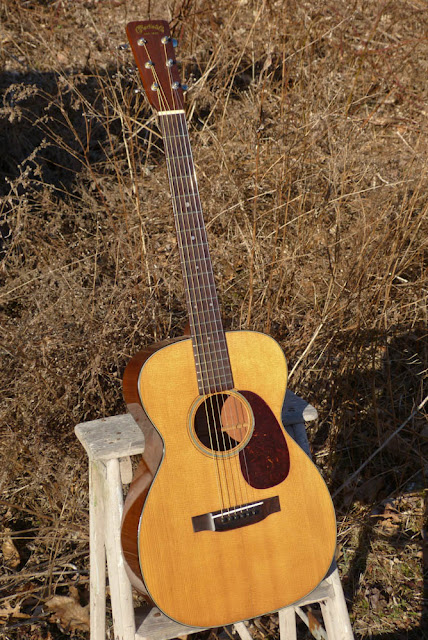1951 Martin 0-18 Flattop Guitar
Update March 2016: The owner brought this back in for resale and it's available again -- this time around with a brand new Martin hard case! I've updated the pictures and description where necessary.
Let's admit it: the early 50s Martins are special. There's an extra something in those first few years of the decade. Maybe it's the tops? Maybe it's the bracing? Maybe it's the good mix between the lighter 30s and 40s bracing and the heavier "contemporary" bracing? Who knows -- but the Martins from '50-53 I've been handling lately seem to have a bit more guts (volume, punch) and also a more substantial lower-mids sound to them than later varieties. That might not be a 100% advantage for, say, a die-hard fingerpicker, but it's a huge advantage for a flatpicker.
Let's admit it: the early 50s Martins are special. There's an extra something in those first few years of the decade. Maybe it's the tops? Maybe it's the bracing? Maybe it's the good mix between the lighter 30s and 40s bracing and the heavier "contemporary" bracing? Who knows -- but the Martins from '50-53 I've been handling lately seem to have a bit more guts (volume, punch) and also a more substantial lower-mids sound to them than later varieties. That might not be a 100% advantage for, say, a die-hard fingerpicker, but it's a huge advantage for a flatpicker.
All that aside, this is a quite clean '51 and, as expected, it sounds terrific. It's louder and fuller than it ought to be and it plays spot-on to boot. The finish is in really, really good shape, with just the very minor handling use and small weather-check one would expect from a 70s model. I'm pretty sure this has not been refinished, however, and has remained clean due to excellent storage. Even the tuners gleam. It doesn't hurt that the playability is spot-on as well.
Work included a fret level/dress, bridge reglue, center-seam cleat on the top, and general cleaning and setup. Per standard 18-series specs, the back, sides, and neck are solid mahogany while the top is solid spruce. The board and bridge are both Brazilian rosewood.
1 11/16" nut width and shallow V/C hybrid neck shape. It's only slightly larger than contemporary Martins after about the 5th fret.
Brazilian rosewood board with pearl dots... and frets in good order.
Strings are 50w-22w on the bottom and 16 and 12 on top. I like this mix for small-body Martins from this time as the lighter build really responds fine with lighter wound strings, but the 16 and 12 give you flatpicking "dig" for lead work.
Of course, the scale is that standard 24.9" Martin "short scale."
I love these old pickguards.
Also, there's a tiny 1" hairline crack to the "left" of the pickguard's edge... it's been drop-filled but is directly over bracing so there's no issue. Typical for Martins. Thee's also a couple of small with-grain scratches under the strings just north of the bridge.
Also, there's a tiny 1" hairline crack to the "left" of the pickguard's edge... it's been drop-filled but is directly over bracing so there's no issue. Typical for Martins. Thee's also a couple of small with-grain scratches under the strings just north of the bridge.
During the bridge reglue I also filled/redrilled the pinholes for better ball-end seating. The bridge itself has some shave to it but I did clean it up a bunch and polished it up. The saddle is the original ivory bit and I've reprofiled it and compensated it as well.
It all came out lookin' good with bridge height and saddle break like on a '30s Martin.
The center seam opened up just a tiny bit in the past and there was a tiny little hairline next to it. At any rate, I added cleats where I could and drop-filled it... but there's so much bracing crossing over it (as well as a bridge plate and endblock) in this area that it's absolutely no concern. It's stable.
The old, original big-plate Klusons work just fine.
The back center-seam shows just a little finish blem along its join on the back (it's not moving/open).
A near-mint new Martin arched-top, hard case (these cost $$) comes with the guitar.
























Comments